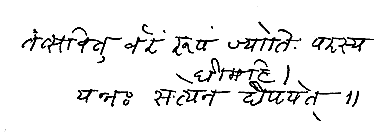|
An
Approach To Indian History
-Prof. Kittu Reddy |
We now enter the next stage of our study of Indian history, the study of the Vedanta or the Upanishads. The word Vedanta means in Sanskrit “the end of the Veda” and it is generally considered as the continuation and offshoot of the Veda. Let us try to see what the word Upanishads means in Sanskrit; etymologically, it means to “sit very near”. The image suggested is of a seeker prepared to sit very close and very near the Teacher who has “seen or realised”. It indicates the spirit of enquiry and suggests that he who wants to know must be prepared to approach and sit near the teacher. It also suggests that both intensity and humility are needed for the seeker of Truth. There are other meanings that are also suggested by the word - as for example, the highest knowledge of the Reality or as interpreted by some as that which shears the Ignorance and leads to the supreme knowledge. In all cases the suggestion is of a strenuous and intense seeking after the Supreme Reality.
As we have seen in the previous chapter, the Vedic language has been considered to be a secret far removed from the languages of the present day. But in the next stage of development, we find a literature which is easier to grasp and understand and which has come to be known as the Brahmanas. The Brahmanas are largely devoted to the explanation of rituals - their significance, their symbolism and the meaning of their observance. But towards the end of the age of the Brahmanas, there came about a revolt against ritualism and a new seeking and a new quest arose. There was a feeling that truth cannot be a matter of ritualism and that it must be sought after without dogmatism or any preconceived belief or idea.
This was the beginning of the age of the Upanishads
Robust thinkers and seekers began to chart out a programme of inquiry, and it has been said that these seekers perfected a discovery which in its importance to the future of human knowledge dwarfs the thought of Newton and Galileo. For they discovered down to its ultimate processes, the method of yoga, and by the method of yoga reached some crowning realisations. They realised that behind and beneath the flux of things, there was a supreme unity and immutable stability which they described as Tat or It. They also realised that reality in itself is consciousness; and perhaps the most important realisation they claimed to have reached is that there is in each individual man that same reality which is identically present in the universe. This realisation was expressed in two famous formulae of the Upanishads: “He am I” - So’ ham and “I am the Brahman” - aham brahmasmi.
The Upanishads have also another importance in the history of Indian spirituality. It was because of the Upanishads that the continuity and line of spirituality was maintained. For a time had come when the original Vedic symbols had begun to lose their significance and pass into an obscurity that had become very difficult to penetrate. The old poise and structure of culture between two extremes was not a sufficient basis for spiritual progress. On one side was the secret spiritual and psychic knowledge for the initiates and on the other was the half-trained natural physical man following the religious cult and symbolism; the gap between these two extremes was too great and there was a danger that the knowledge might be lost as it happened in Greece. Here, that is to say in Greece, the inner teaching of the Mysteries was followed by the more intellectual but less inspired knowledge of the Pythagoreans and Plato; and it is this trend that has been the characteristic aim and line of growth of Greek and Western civilisation in the later ages. Its main aim has been a strong and fine culture of the vital and physical man by the power of the idealised intellect and not as in India the raising of these parts to their spiritual fulfilment.
Indian culture and civilisation was saved from this trend by the effort of the Upanishads. The Vedantic seers renewed the Vedic truth by extricating it from the cryptic symbols and casting it into a more direct and powerful language of intuition and inner experience. It was not the language of the intellect but it still wore a form which the intellect could take hold of and was therefore more accessible to a larger number of people. It thus became the starting point of an ever widening circle of seekers and deep philosophic speculation.
The Upanishads are at once profound religious scriptures,- for they are a record of the deepest spiritual experiences,- documents of revelatory and intuitive philosophy of an inexhaustible light, power and largeness and, whether written in verse or cadenced prose, spiritual poems of an absolute, an unfailing inspiration inevitable in phrase, wonderful in rhythm and expression. It is an expression of mind in which philosophy and religion and poetry are made one, because this religion does not end with a cult nor is limited to a religio-ethical aspiration, but rises to an infinite discovery of God, of Self, of our highest and whole reality of spirit and being and speaks out of an ecstasy of luminous knowledge and an ecstasy of moved and fulfilled experience.
There are more than two hundred Upanishads, but the most important of them are twelve in number. These are: Isha, Kena, Prashna, Mundaka, Mandukya, Taittiriya, Aitareya, Chhandogya, Brihadaranyaka, Svetasvatara, Brahmabindu. Of these, the Isha occupies a very special place. It is the shortest Upanishad, having only eighteen verses, and yet it is said to contain the quintessence of the entire quest expressed in the Upanishads. It describes the nature of Reality; it puts forth the aim of life that seems to be implied by the nature of the universe, and by the reality that is in the universe and in man.
One singular message that comes out clearly in the Isha Upanishad is that all contraries meet when one reaches the heights of realisation
The Upanishads are known as Vedanta, not only because they came at the end of the Vedic age, but also because the highest discoveries of the Veda are supposed to be contained in the Upanishadic teachings. Vedanta grew into a school of philosophy in a later period of ancient Indian history, but the original Vedanta was not a philosophy but a dialogue or a collection of insight and intuitions of the seers.
The Upanishads maintained that the senses do not give us true knowledge. They also maintained that while the reason, in its pure ideative movements, can grasp the essential truth of reality, it cannot give a concrete experience of that truth. The Upanishadic seers like modern science developed a method of arriving at knowledge which can be verified through experience. They cultivated the faculty of intuition and illumination through which an individual could experience truth by a process of identity. Knowledge by identity was the special method of the Upanishads.
Each one of these Upanishads deals with a separate subject of spiritual contemplation or aspect of the spiritual life and has becoming the starting point of the later philosophies.
We shall now explain some of the verses of the Upanishads to show its great importance in the formation of the essential values of Indian spiritual thought and experience. The verses chosen are from the Isha Upanishad which although the smallest in size is also the most pregnant with profound truths and ideas.
The Isha Upanishad is made up of only eighteen verses or slokas; yet they contain some of the most important concepts of Indian spirituality. It is one of the more ancient of the Vedantic writings. The principle it follows throughout is the uncompromising reconciliation of uncomprising extremes. Let us take as an example the first two slokas of the Isha Upanishad:
“All this is for habitation by the Lord, whatsoever is individual universe of movement in the universal motion. By that renounced thou shouldst enjoy; lust not after any man’s possession”.
“Doing verily works in this world one should wish to live a hundred years. Thus it is in thee and not otherwise than this; action cleaves not to a man”.
In these two slokas the conception of the rule of a divine life for man is founded, - enjoyment of all by renunciation of all through the exclusion of desire.
One should wish to live a hundred years so that one can have absolute enjoyment; but in order to do this one must not allow action to cleave to man; in other words one must act without attachment. To be without attachment is to be without desire, that is to say one must renounce all desire. It is only by absolute renunciation of desire that one can have absolute enjoyment. Here one can see that renunciation is not giving up of material and external things, but giving up attachment and craving which is the whole root of desire.
In sum, absolute enjoyment is possible only by absolute renunciation.
We thus see that the Vedas and the Upanishads laid the foundation of the spiritual life of India. What the Vedas presented in mystic language, the Upanishads gave in intuitive and intellectual language. The direction given to Indian culture was of a spirituality in the midst of life and not other-worldly. We shall take up this aspect in the later chapters.
 |



